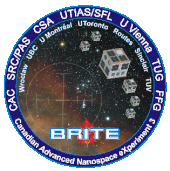


A replica of Heweliusz (BRITE-PL)
| |
| Country of origin | Canada Austria Poland |
|---|---|
| Applications | Astronomy |
| Specifications | |
| Bus | Generic Nanosatellite Bus |
| Launch mass | 10 kilograms (22 lb) |
| Dimensions | 20 centimetres (7.9 in) cube |
| Regime | Low Earth |
| Production | |
| Status | Operational |
| Built | 6 |
| Launched | 6 |
| Operational | 3 |
| Retired | 2 |
| Lost | 1 |

BRITE-Constellation is an ongoing space mission carrying out two-band photometry in wide fields with a constellation of six (presently, three operational) BRIght Target Explorer (BRITE) nanosatellites. The mission was built by a consortium of three countries, Canada, Austria, and Poland, each operating two BRITE satellites. The six satellites were launched into low-Earth orbits between February 2013 and August 2014. Each satellite is a cube-shaped spacecraft with sides of 20 centimetres (7.9 in) hosting an optical telescope of 3 centimetres (1.2 in) aperture feeding an uncooled CCD with a field of view of approximately 20° × 24°. The satellites were intended for photometry of the brightest stars in single passband located in the blue (three satellites) or red (the other three satellites) part of the optical range.
The idea of using microsatellite for scientific observations, especially for photometry of bright stars, was born during discussions on possible designs for Canada's first scientific satellite. Discussions led by Kieran Carroll and Slawek Rucinski (University of Toronto) led to three concepts, including a wide-field imager for photometric measurements.[1] A design concept for an astronomical nano-satellite was developed in 2002 by the Institute for Aerospace Studies at the University of Toronto under the Canadian Advanced Nanospace eXperiment Program as Can X-3 in cooperation with a team of Canadian astronomers, headed by Slavek Rucinski, as a first fully three-axis stabilized satellite of 20 cm × 20 cm × 20 cm size. In September 2004, a workshop on nano-satellites for astronomy was organized in Vienna in cooperation with the Austrian Space Agency (ASA, now Aeronautics and Space Agency of the FFG). A proposal from the Institute of Communication Networks and Satellite Communications of the Graz University of Technology, led by Otto Koudelka, for funding of BRITE-Austria (TUGSat-1) was accepted by ASA in 2006 and was built at TUG in cooperation with SFL. In March 2005 a program for improving the infrastructure of Austrian Universities was established by the Austrian Ministry of Science and Technology, to which the University of Vienna submitted a proposal for UniBRITE (PI: Werner W. Weiss), which was accepted in October 2005 and UniBRITE was ordered at SFL. Following an initiative by Slavek Rucinski, Aleksander Schwarzenberg-Czerny (CAMK) was able to obtain funding for two Polish BRITE satellites at the end of 2009. Following that, the Canadian Space Agency (CSA) finally funded BRITE-Toronto and BRITE-Montréal (PI: Anthony Moffat, University of Montréal) in 2011. Hence, BRITE-Constellation was born as a collaboration between Austria, Canada and Poland.
The six BRITE nanosatellites were lifted into low-Earth orbits in four independent launches carried out by three space agencies: Indian Space Research Organisation (two Austrian satellites), Roscosmos (two Canadian satellites and Polish BRITE-Lem), and China National Space Administration (Polish BRITE-Heweliusz). Details of the launches are summarised in the table below.
| Satellite name | Abbr | Launch date | Status | Launch vehicle | Launch site |
|---|---|---|---|---|---|
| UniBRITE | UBr | 25 Feb 2013 | Stopped observing | PSLV-CA | Satish Dhawan Space Centre First Launch Pad |
| BRITE-Austria | BAb | 25 Feb 2013 | Operational | PSLV-CA | Satish Dhawan Space Centre First Launch Pad |
| BRITE-Lem | BLb | 21 Nov 2013 | Stopped observing | Dnepr | Dombarovsky (air base) Site 13 |
| BRITE-Toronto | BTr | 19 June 2014 | Operational | Dnepr | Dombarovsky (air base) Site 13 |
| BRITE-Montréal | BMb | 19 June 2014 | Failed to deploy [2] | Dnepr | Dombarovsky (air base) Site 13 |
| BRITE-Heweliusz | BHr | 19 Aug 2014 | Operational [3] | Long March 4B | Taiyuan Satellite Launch Center |
Canadian BRITE-Montréal failed to detach from the launcher for unknown reasons and was lost. The other five satellites successfully passed the commissioning phase and began regular observations. The nominal lifetime of the BRITE satellites was foreseen to be two years. Due to problems with the attitude control system (ACS), observations with UniBRITE were suspended in August 2019, more than six years after its launch. About a year later, in May 2020, BRITE-Lem started to suffer from similar problems and observations with this satellite, also after more than six years in orbit, were suspended. Currently, the three remaining satellites, BRITE-Austria, BRITE-Toronto and BRITE-Heweliusz, are still active. Regardless of their status, observations with the BRITE satellites, and thus the entire mission, are expected to be completed by the end of 2024.
BRITE satellites are made up of the following subsystems:[4][5]
|
Bright Target Explorer constellation
| |
|---|---|
|